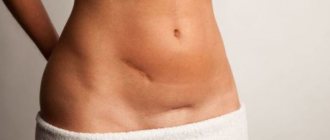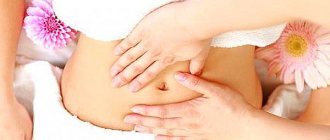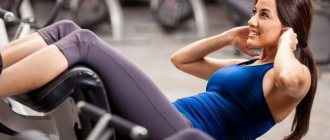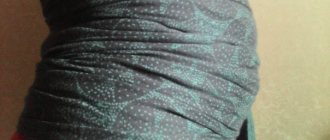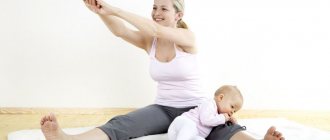The baby was born. You return from the maternity hospital and realize that you cannot fit into the clothes you wore before pregnancy. Even if you exercised during pregnancy, you still gained weight. There's no escape here. The main thing is don’t panic! Through exercise, you can achieve significant results by setting yourself the goal of losing weight.
The question immediately arises: will sports during lactation harm the baby? What sports can you do and which cannot?
Exercising is very beneficial for women during the postpartum period. In order not to harm themselves and the baby, nursing mothers should carefully follow the rules of physical training. You definitely need to monitor your well-being. If you feel unwell, stop exercising and consult your doctor.
What happens to the body during pregnancy and after childbirth?
Carrying a child reshapes a woman’s entire body in favor of the full development of the baby.
The level of estrogen and progesterone, the main female hormones involved in metabolic processes, drops. This leads to rapid accumulation of fat.
Weight gain is also explained by possible edema, increased blood volume, increased mass of the mammary glands, and the growth of the child and the surrounding membranes.
After childbirth, a considerable part of the weight gained by a woman is lost due to:
- loss of amniotic fluid and a certain amount of blood;
- weight of the born baby;
- discharge of the placenta.
If the expectant mother had swelling, it will subside during this period as it becomes easier for the kidneys to work. But the fat layer will not disappear on its own.
Exercising after childbirth is the impetus that will allow you to lose “excess” in a short time, because strict diets are not recommended for breastfeeding women.
What you should absolutely not do
Sports activities are contraindicated if a woman is diagnosed with the following pathologies:
- endometritis and uterine bleeding;
- poor fusion and suture divergence;
- elevated body temperature for a long time (indicates the presence of an inflammatory process in the body);
- diseases of the uterus.
For everyone else, the following physical activity is not recommended for the first two to three months after birth (while postpartum discharge—lochia) is observed and the uterus contracts:
- jumping;
- run;
- squats;
- push ups;
- lifting weights, using weights;
- sharp twisting, bending;
- jumping rope;
- load on the lower back;
- load on the abdominal muscles.
Such actions can provoke a number of problematic conditions:
- increased pressure in the pelvic floor;
- involuntary urination;
- excessive tension of seams;
- increased bleeding from the genital tract;
- uterine bleeding;
- disruption of the uterine restoration processes.
Any intense physical activity, and even more so extreme sports (parachute jumping), professional training that requires too much energy, is strictly prohibited in the first months after childbirth, and for nursing mothers - for the entire period of breastfeeding. It is important not to overdo it when trying to get in shape, because the body takes several months to fully recover after pregnancy and childbirth. Also, you should not engage in sports that seriously strain the heart and muscles:
- light and weightlifting;
- volleyball, basketball, football and similar sports;
- cycling;
- tennis;
- run.
Aerobic exercise (classical aerobics, pump, step and the like) is not recommended for nursing mothers, as they require large amounts of fluid and energy by the body, and also expose the mammary glands to excessive fluctuations (due to a large number of jumps).
Sports that require significant energy expenditure are not recommended for nursing mothers
In any case, if you experience discomfort or pain while performing any exercises, you should stop exercising and consult a specialist.
When can I start classes?
It is not difficult to determine the period when you can play sports after childbirth - focus on the well-being and condition of the body.
If you are not diagnosed with postpartum depression, and caring for a child does not tire you too much, your body will give a sign.
Does postpartum discharge continue? This means that the time for sports has not yet come. If the birth took place by caesarean section, you should avoid increased stress, especially abdominal exercises, for 6 weeks after surgery.
When choosing a type of physical activity, the main thing is not to overdo it. After the birth of a child, a woman experiences slight deformation of the pelvic bones, chest, spine and spinal muscles.
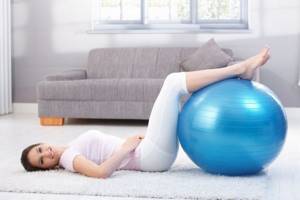
Therefore, the woman in labor experiences minor pain in the listed organs, which persists for 1–2 months.
Also, the occurrence of an additional psycho-emotional surge and the stress experienced leads to completely normal manifestations of discomfort and lethargy after the difficult process of childbirth. This is a natural, residual postpartum condition that will pass. Of course, this will make it somewhat difficult to restore shape at first.
Obstetricians, on the question: “How long after giving birth can you go in for sports?”, express the opinion that the sooner you start, the sooner the body will return to its pre-pregnancy norm.
But, since all cases are individual, the local gynecologist must give the go-ahead for sports after childbirth.
Lesson plan for women while breastfeeding
During pregnancy, not only muscle strain occurs: hormonal levels change, and the load on the spine increases. After childbirth, the body slowly returns to its pre-pregnancy state, so you should be careful when playing sports.
Table. When after childbirth can you start playing sports and how to dose the load without complications
| Postpartum period | Recommended movements |
| 2-3 months | 1. Kegel exercises. During the day, periodically tense and relax the vaginal muscles. Normalizes the tone of the uterus, promotes narrowing of the vagina and increased sensitivity during sex. 2. Circular movements of the pelvis. 3. Alternating fast and slow walking. You can do this while pushing a stroller with a child along the sidewalk. 4. Tilts and rotations of the body. 5. Swings and rotations with your arms. 6. Circular movements in the ankle and knee joints. First, repeat the exercises 2-3 times, gradually increasing the number of repetitions to 15. Increase the duration of active walks with a stroller to 2 hours. |
| After 3 months (during this period the body has partially returned to normal and more active training is allowed) | 1. Squats. 2. Swing your legs. 3. Rotation of the limb at the hip joint. If there are no contraindications, then moderate stress on the press is allowed. Movements are performed while lying on your back: · raising and lowering the pelvis (shoulder blades pressed to the floor); · pulling the lower limbs bent at the knees towards the stomach. The load increases gradually. You need to start with 2-3 repetitions and gradually increase the number to 10-25. |
Sports after childbirth when breastfeeding from 3 months are recommended to be supplemented with dancing, swimming or yoga. But at the same time, it is important not to overwork and enjoy the training.
When you can start full-fledged sports after childbirth, doctors decide individually. In some women, by the end of 3 months, the body has already recovered from labor, while in others the recovery period is still ongoing. Those who give birth for the first time after 30 years or those suffering from chronic diseases take longer to recover.
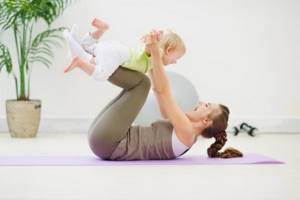
Exercises can be done with your child
Physical activity during the postpartum period
At first, a woman may experience involuntary urination when coughing, laughing, or sneezing. This is a sign that the obturator muscle in the bladder has become slightly stretched during pregnancy.
Kegel exercises will help you cope with this problem:
- Squeeze your vagina with force 15-20 times twice a day.
- Release urine in doses, alternating portions with squeezing the vagina.
If the birth took place with complications, ruptures, or a caesarean section was performed, the “rising” from the hospital bed should be done gradually, but try to get back on your feet as quickly as possible.
Start with simple “walking” walks around the ward, this will avoid thromboembolic complications and adhesions. Read more about complications after cesarean section→
First exercises and tips for doing them
Physical education should be done from the first days after childbirth, increasing the load on the body gradually and carefully. Some useful tips:
- Empty your bladder before exercising;
- do exercises after feeding the baby;
- make sure that the room temperature at the time of classes is 18–20 degrees;
- choose loose clothing that does not restrict movement;
- after each group of exercises, you need to lie on your stomach, this helps to speed up the contraction of the uterus and reduce the volume of the abdomen;
- move smoothly, as if in slow motion, without sudden lunges.
For women who are accustomed to an active lifestyle and want to return to society as quickly as possible, the question is: “Sports after childbirth, when can I start?” is of fundamental importance.
We offer a set of simple exercises for those who want to bring their appearance in accordance with modern requirements. If there are no complications, you can start training after being discharged from the hospital. They are carried out in a lying position (on a bed or mattress).
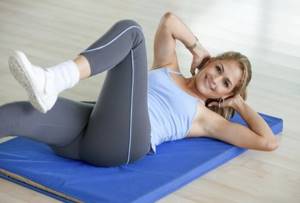
A set of simple exercises:
- Hands lie along the body. We exhale - we pull our stomach in to the limit. Inhale - relax.
- Lying position. The knees are bent, exhale - the pelvis rises, inhale - lowers.
- Lying on the bed. Hands to the side. Raise the chest, trying to close the shoulder blades without lifting the head from the pillow. Exhale – return to the starting position.
- We lie on our stomachs. Bend each leg at the knee alternately 10–15 times.
- Lying on your back, perform the “bicycle” exercise. When we get tired we finish.
- We grab the side of the bed with our hands. The knees are bent. Without lifting your feet from the mattress, we alternately tilt the legs closed together to the left and right 5-10 times.
- Rotation of the feet raised above the abdomen. 10 times with the left foot, 10 times with the right.
- Rolling on the bed. Turn sideways first to the left several times, then to the right.
Even those who were professionally involved in sports before giving birth should not overdo it from the first days. Everyone needs to start the same way, gradually increasing the load.
Prohibited exercises
Doctors do not recommend swimming until seven days after vaginal discharge has stopped. If you had stitches or a caesarean section, you should start exercising after you have been seen by your doctor six weeks after giving birth. In addition, it is not recommended to exercise in the knee-elbow position for several weeks, because there is a possibility of developing an air embolism (the formation of air bubbles at the placenta attachment site). There is no need to practice fitness if less than six weeks have passed since the birth of the child.
What sports are allowed after childbirth?
Medical experts do not advise starting sports immediately after giving birth. For some it takes one month to recover, for others even a year is not enough.
What you need to consider when deciding what sports you can do after giving birth:
- age;
- state of the body;
- Availability of conditions for studying at home.
The ideal solution for body shaping is dance. Oriental belly dance is specifically designed for “sculpting” shapes in problem areas. Soft, smooth movements of the arms, legs and torso are an excellent way to restore blood flow in the joints of the limbs and strengthen the muscles of the chest and arms.
Swimming. You can swim 2-3 times a week if the uterus does not bleed and there is no pain. Water is a universal natural trainer that makes the muscles of the legs, arms, and torso work. It is in water that the highest “return” of calories is achieved!
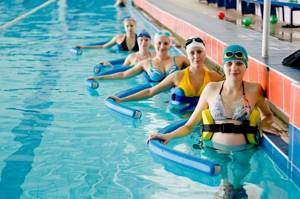
Each exercise for various problem areas is repeated 5 to 10 times. Training in the pool should begin with 15-20 minutes, gradually increasing the load and training time up to an hour.
Pilates is a gentler form of fitness that can be done at home. Constantly practicing this sport engages the abdominal muscles, making it perfectly elastic and rigid with regular exercise. Exercises for the spine form a graceful posture and remove lateral deposits in the waist and hips.
Useful tips
During fitness classes, it is recommended to drink a lot of clean, still water to avoid dehydration. It is important for young mothers to eat right and walk a lot in the fresh air. It is especially useful to spend time in coniferous and deciduous parks, away from harmful emissions.
The first workouts after childbirth should be done in a gentle manner. First of all, it is important to pay attention to the abdominal area. Optimal exercises include Pilates or yoga, which further strengthen the pelvic floor muscles. With the help of a gymnastic complex, you can tone the lower abdominal muscles, stabilize the spine, and distribute the load on the musculoskeletal system of the body. At the second stage of physical activity, to achieve attractive forms, you should train the pelvic muscles. The final stage is exercises for the upper back and neck muscles. This complex is especially relevant during breastfeeding, as it helps stimulate lactation.
A set of exercises on a large exercise ball not only keeps your muscles toned, but also lifts your spirits. Simple and effective exercises on sports equipment do not require much physical effort. Rolling and twisting while sitting on a ball helps relieve tension in the back and works well on the lateral muscles in the waist.
An integrated approach to the training system, proper nutrition and a positive attitude will bring the expected results. Regular exercise will give you beauty and strength to enjoy the joy of motherhood.
What sports are contraindicated after childbirth?
Experienced obstetricians recommend not to rush into active activities until the woman gets stronger.
For some women, the question is: “Sports after childbirth, when to start”? has a special pungency. These are female athletes, their recovery time is reduced to several months, after which they begin active training again.
In some cases, this is acceptable, but medicine is against the hobby of weightlifting, long jogging, tennis, and cycling.
Do not forget that the main task of a young mother is to raise a healthy baby. Each woman should independently create a schedule for herself when she can start playing sports after childbirth, balancing her capabilities and strengths.
Author: Lyudmila Shashkova, especially for Mama66.ru
What effect does pregnancy have on the female body?
A woman’s body changes while expecting a child, this is primarily due to the fact that all internal resources are activated in the direction of protecting and developing the fetus. Hormonal levels change, metabolic processes slow down, which can result in weight gain. In addition, the pressure placed on the kidneys causes constant swelling, causing additional discomfort.
Our additional services: Bioimpedance | Marutaka Massage | Pressotherapy | Ion-Detox
Over time, along with the baby, the blood volume grows, the mammary glands fill, the amniotic membranes increase, so weight can rapidly increase. During childbirth, a woman loses most of the kilograms she had gained, the functioning of internal organs is restored, and swelling goes away.
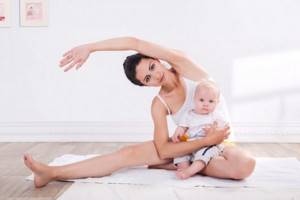
However, if you do not adhere to a diet during pregnancy and “eat for two,” the problem of excess weight can be aggravated by fat deposits (usually around the waist and hips).
Comment from clinic nutritionist Elena Morozova:
To avoid the difficulties of postpartum recovery, it is recommended to monitor your diet - it should be balanced and beneficial for the health of the mother (especially the nursing mother). Healthy eating habits will help you quickly get into shape and get back into your daily routine. For an individual diet program, you should contact the professionals at our clinic. They will help you choose the necessary nutritional complex that will help maintain harmony between weight and optimal body condition in the initial period of caring for your child.
